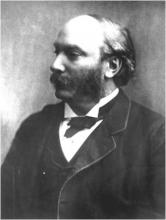The Old Cavendish - "The First Ten Years"
by Dennis Moralee
from the booklet "A Hundred Years and More of Cambridge Physics".
Rayleigh's Term of Office
The regulations for the Cavendish chair clearly said it was to terminate at Maxwell's death unless the Senate decided otherwise. The Senate must have been convinced of the value of the Cavendish, for it immediately offered the chair to Lord Rayleigh, who was universally agreed to be the only successor to Maxwell.
Of the eight Cavendish Professors who have so far headed Cambridge physics, Rayleigh is perhaps the least known, and his period of occupancy of the chair is certainly the most difficult to write about. Firstly because his researches, although covering a wide field, were completely classical, and one tends to jump straight from the Maxwell era to the atomic physics of J.J. Thomson's tenancy. Secondly because his most important work in Cambridge was concerned with the re-determination of the absolute values of various electrical quantities, notably the ohm. Such work is always vital, and was particularly so then, but definitely not as glamorous as original research. Thirdly, all the major discoveries of Rayleigh's, particularly those for which he is famous (for example, the noble gases), were made at his private laboratory at Terling, to which he returned after his time at the Cavendish.
Perhaps Rayleigh would not have accepted the chair at all had there not been an agricultural depression at the time. Rayleigh's estate depended on his dairy herds, and in particular on the chain of dairy shops and milk-rounds that he operated in London, cutting out the middleman. "Lord Rayleigh's Dairies" were a well known and profitable business, but it so happened that in 1879 profits were falling. Consequently Cambridge gained one of the greatest classical physicists.
On arriving at the Cavendish, Rayleigh discovered that the lab was severely under-equipped. In spite of Maxwell having continuously added apparatus of his own, the growth in the number of students had left a real shortage. Rayleigh modestly asked for a fund of £1,500. The Duke gave £500, Rayleigh himself contributed £500, and the rest was soon raised. It was generally thought odd that more equipment was necessary, for Maxwell in a report of 1877 had stated that "the Chancellor has completed his gift of apparatus." Somehow this was changed by word of mouth into the statement that the Chancellor had completely equipped the Cavendish. In fact the Chancellor's gift was quite insufficient. The type of equipment used at the Cavendish in those early days can be seen from the part of Maxwell's report reprinted.
In addition to the gift of new equipment, Rayleigh also expanded the workshops, but his most important step was the setting up of an organised practical course. Garnett left after Maxwell's death, and in his place were appointed jointly (Sir) R.T. Glazebrook and W.N. Shaw. Together they perfected the new type of practical teaching that is now standard - a series of set experiments are laid out and allotted in rota to the students. Handouts are available and the demonstrator wanders round solving any problems that arise. Trivial as this step forward may seem, it completely revolutionised practical instruction. Rayleigh himself did a lot of preparatory work, and Glazebrook and Shaw's book on Practical Physics became the standard (and only) practical textbook for many years.
The division of the N.S.T. into two parts had enabled advanced as well as elementary classes to be operated. The complete lecture list for 1880 is reproduced below. The practical classes were for two hours, three days per week. Attendances were still fairly small - 16 at Rayleigh's lectures, 18 doing Heat, 14 doing Advanced Electricity. However the numbers soon grew and some demonstrations had to be duplicated.
The organisation of this expanded laboratory was a major task and Rayleigh was responsible for a great deal of it. Still, in his five years at the Cavendish, he managed to publish fifty papers - a Nobel Prize was founded in 1904 on this tremendous body of work. It was the first such recognition of the scientific work of the Cavendish, and forms a fitting conclusion for a review of the first decade of Cambridge physics.

